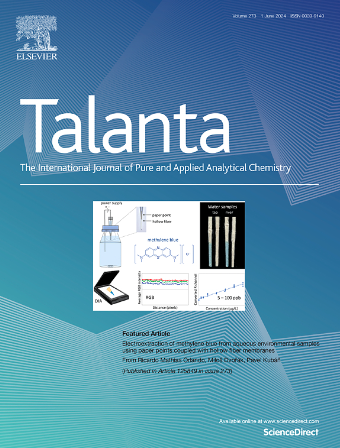Waveguide microwave gas sensor based on monolithic In2O3 for enhanced ammonia detection
IF 5.6
1区 化学
Q1 CHEMISTRY, ANALYTICAL
引用次数: 0
Abstract
For commonly used chemical resistance sensors, achieving room-temperature detection often results in reduced performance. Microwave gas sensors have been rapidly expanding in recent years, attributed to their advantages of room-temperature operation and low power consumption. Waveguide, as a three-dimensional microwave circuit with separated electric and magnetic field distributions, resulting in high quality factor, is expected to significantly enhance the sensitivity of microwave sensors. Additionally, the hierarchical porous structure of monolithic In2O3 facilitates gas diffusion, further enhancing sensing performance. Herein, a microwave gas sensor is designed by applying porous monolithic In2O3 and waveguide resonator. By adjusting the content of the polymer PVP, In2O3 with different pore sizes is synthesized in which hierarchical porous In2O3 sample with a PVP content of 3.0 g (3.0-HPS In2O3) exhibits the best NH3 sensing properties, including a wide concentration range (0.01–2000 ppm), a low limit of detection (LOD) of 7 ppb, excellent selectivity, good moisture resistance, and long-term stability. This study offers a promising approach for the development of room-temperature ammonia gas sensors with an extended detection range and has preliminarily explored the influence of pore sizes on gas sensing performance.

求助全文
约1分钟内获得全文
求助全文
来源期刊

Talanta
化学-分析化学
CiteScore
12.30
自引率
4.90%
发文量
861
审稿时长
29 days
期刊介绍:
Talanta provides a forum for the publication of original research papers, short communications, and critical reviews in all branches of pure and applied analytical chemistry. Papers are evaluated based on established guidelines, including the fundamental nature of the study, scientific novelty, substantial improvement or advantage over existing technology or methods, and demonstrated analytical applicability. Original research papers on fundamental studies, and on novel sensor and instrumentation developments, are encouraged. Novel or improved applications in areas such as clinical and biological chemistry, environmental analysis, geochemistry, materials science and engineering, and analytical platforms for omics development are welcome.
Analytical performance of methods should be determined, including interference and matrix effects, and methods should be validated by comparison with a standard method, or analysis of a certified reference material. Simple spiking recoveries may not be sufficient. The developed method should especially comprise information on selectivity, sensitivity, detection limits, accuracy, and reliability. However, applying official validation or robustness studies to a routine method or technique does not necessarily constitute novelty. Proper statistical treatment of the data should be provided. Relevant literature should be cited, including related publications by the authors, and authors should discuss how their proposed methodology compares with previously reported methods.
 求助内容:
求助内容: 应助结果提醒方式:
应助结果提醒方式:


